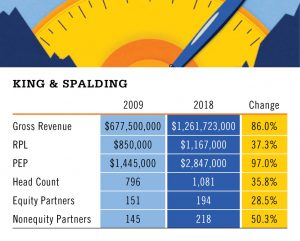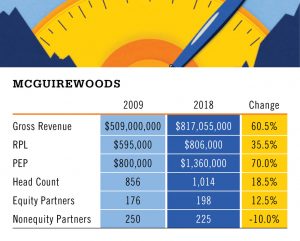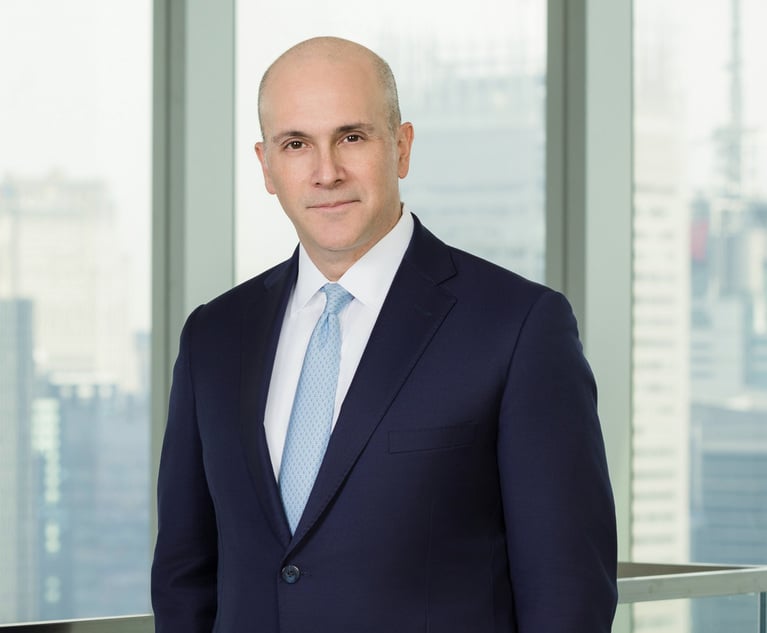Crash Course: How a Small Group of Firms Pivoted and Profited After the Recession
Firms including Cooley, Paul Weiss, McGuireWoods and King & Spalding used the Great Recession to chart a new path to success.
April 23, 2019 at 09:52 AM
13 minute read
 Credit: Egle Plytnikaite.
Credit: Egle Plytnikaite.
Before 2008, most law firms could get a piece of the pie without much strategy guiding how they got it. And then the pie was gone.
The Great Recession changed the global economy and the legal industry as we knew it. In the decade since, very few firms have had a solid stream of revenue increases, Bruce MacEwen and Janet Stanton of law firm consultancy Adam Smith, Esq. say.
 Leverage the Am Law 100 data with firm comparison and key performance data, exclusively on Legal Compass. Access Premium Content
Leverage the Am Law 100 data with firm comparison and key performance data, exclusively on Legal Compass. Access Premium Content Since fiscal year 2009, only 27 of the 100 firms on the Am Law rankings have had year-over-year growth in revenue, according to ALM Intelligence data.
The firms that are pulling away share some characteristics, Stanton says. They tend to operate in a more business-like way, which means a focus on profitability, intentional planning, strategic intake and succession planning for leadership roles and client management, she says.
"From the 1980s to 2008, law land didn't have to do any of these things, so these firms that are pulling away changed their strategy," Stanton says.
These firms have been able to get it right for nearly a decade, and each had to develop a unique strategy to make it happen. To understand how a select group of firms turned the recession into an opportunity to thrive, not just survive, The American Lawyer spoke with a group of leaders who played a pivotal role in reimagining their firms' trajectories.
The firms that have delivered year-over-year growth since the 2009 fiscal year include: Akin Gump Strauss Hauer & Feld; Baker & Hostetler; Barnes & Thornburg; Cooley; Davis Polk & Wardwell; Duane Morris; Fox Rothschild; Fragomen, Del Rey, Bernsen & Loewy; Gibson, Dunn & Crutcher; Goodwin Procter; Holland & Knight; Jackson Lewis; King & Spalding; Kirkland & Ellis; Latham & Watkins; McGuireWoods; Milbank; Morgan, Lewis & Bockius; Ogletree, Deakins, Nash, Smoak & Stewart; Paul, Weiss, Rifkind, Wharton & Garrison; Perkins Coie; Polsinelli; Proskauer Rose; Ropes & Gray; Sheppard, Mullin, Richter & Hampton; Simpson Thacher & Bartlett; and Williams & Connolly.
California Hustle
Joe Conroy became CEO of Cooley in January 2008. In his first address at a partner meeting, he laid out his plans for the Silicon Valley firm's aggressive growth strategy that included a global footprint and other truisms—or at least what he thought were truisms.
"They didn't throw rotten fruit at me, but it's because they didn't have rotten fruit," Conroy says. "They weren't really buying it."
But he had a fundamental concept he wanted to instill in the minds of the firm's partners: The recession, for however long it would last, presented an opportunity.
Conroy joined the firm in 1999, immediately ahead of the dot-com crash that "should've, candidly, killed a firm that was configured the way our firm was configured," he recalls.
 Joe Conroy
Joe ConroyBut after the crash, Cooley began rebuilding, trying to dispel the notion that it was simply a West Coast firm. Its strategy—if it had one back then—was to be a better tech firm, Conroy says. It invested in its vibrant emerging companies and life sciences practices and worked with venture capital funds, including fund formation and investment deals. It also looked to invest in its East Coast operations, leading to a 2006 merger with New York litigation boutique Kronish Lieb Weiner & Hellman that created Cooley Godward Kronish, a 550-lawyer national firm.
The firm was cruising along, with its revenue jumping over 44 percent from 2006 to 2007. But when the recession hit, it hit Cooley, like most other firms, hard. Revenue fell 8.2 percent and profits per partner tumbled 11.4 percent from 2008 to 2009. But as Conroy assumed leadership of the firm, he remained steadfast in his conviction that the firm needed to use the recession to separate itself from the pack.
"For us to succeed, we didn't need to outrun the bear," Conroy says. Cooley just needed to outrun its competition.
 The recession was the tipping point for bifurcation in the legal industry, and the number of firms that could ably compete for the best business was about to shrink, Conroy says. Cooley developed a strategy of becoming "elite and distinctive"—elite in its finances, branding, clients and geographical coverage, and distinctive in its focus on tech, life sciences and venture capital. And, more important, Conroy adds, it would set itself apart in its representation of high-growth, innovative companies, safe in the knowledge that partnering with the biggest and most powerful companies in the world would allow the firm not only to stay at the forefront of growing fields, but to pedal back as the point of entry into big-ticket work, Conroy says.
The recession was the tipping point for bifurcation in the legal industry, and the number of firms that could ably compete for the best business was about to shrink, Conroy says. Cooley developed a strategy of becoming "elite and distinctive"—elite in its finances, branding, clients and geographical coverage, and distinctive in its focus on tech, life sciences and venture capital. And, more important, Conroy adds, it would set itself apart in its representation of high-growth, innovative companies, safe in the knowledge that partnering with the biggest and most powerful companies in the world would allow the firm not only to stay at the forefront of growing fields, but to pedal back as the point of entry into big-ticket work, Conroy says.
That strategy has paid dividends. Since 2009, gross revenue at Cooley has grown nearly 142 percent. Net income has ballooned 168 percent. Revenue per lawyer is up 61 percent. The firm has grown its partnership ranks by nearly half, and still more than doubled its profits per partner in the process.
"This firm is based on hustle," Conroy says. "We've got this business development gene in our DNA and there's this real affinity for the collective rather than the individual."
The Wall Street Warrior
Like Conroy, Brad Karp stepped into his role as chairman of New York City-based Paul, Weiss, Rifkind, Wharton & Garrison just a few months before Lehman Brothers filed for bankruptcy in September 2008. But Karp was in a much different position.
 Brad Karp. Photo: David Handschuh/ALM.
Brad Karp. Photo: David Handschuh/ALM.The firm represented—and continues to represent—several of the largest financial institutions that in 2008 were under siege as a result of the global financial collapse. Its litigation team served as lead counsel to JPMorgan Chase/Bear Stearns in lawsuits stemming from the global investment bank's collapse. It defended Bank of America in litigation surrounding its $50 billion merger with Merrill Lynch in 2008. And it also represented Citigroup Inc. in subprime- and credit-related cases, as well as the investment bank's involvement in the Enron and Parmalat fraud cases.
"Our firm had record-breaking levels of activity during the financial crisis," Karp says. "Our litigators and white-collar defense lawyers, in particular, worked around the clock for years, handling massive investigative matters and litigations for our Wall Street bank clients."
All that work generated a lot of revenue. The firm took the capital and invested it in its five core practice areas.
"Our goal was to develop market-leading practices in litigation, white-collar defense, public M&A, private equity and restructuring. To achieve this, we needed to make some bold strategic investments and wisely deploy some of the capital we had created," Karp says.
The investment reflected a larger plan implemented by Karp at the beginning of his tenure.
"One of my first actions as chair, back in 2008 and 2009, was to shift resources away from certain niche practices and geographic regions that were peripheral to our strategy and to focus our energies on mission-critical, client-centric practices for a firm centered in New York and Washington," he says.
The firm was able to do it, he says, because "our profitability was soaring at a time when industry profits were plummeting."
 Growing client demand also allowed Paul Weiss to make strategic investments in its partnership ranks at a time when most other firms were shrinking ranks. Since 2009, the firm has grown its partnership by 25 percent. Over the same time period, its Wall Street peers—Cravath, Swaine & Moore; Cadwalader, Wickersham & Taft; Davis Polk & Wardwell; Sullivan & Cromwell; and Wachtell, Lipton, Rosen & Katz—have all decreased their partnerships.
Growing client demand also allowed Paul Weiss to make strategic investments in its partnership ranks at a time when most other firms were shrinking ranks. Since 2009, the firm has grown its partnership by 25 percent. Over the same time period, its Wall Street peers—Cravath, Swaine & Moore; Cadwalader, Wickersham & Taft; Davis Polk & Wardwell; Sullivan & Cromwell; and Wachtell, Lipton, Rosen & Katz—have all decreased their partnerships.
"We needed to be certain that we had the necessary resources, especially at the partner level, to handle the work at the highest possible level and impress our clients. This required us to bring in additional talent and invest in the partnership," Karp says. "Pursuing this strategy, at that time, was unconventional."
And adding to the partnership in the firm's core areas has been critical ever since, Karp notes. In the years following the recession, the firm made high-profile additions like top Cravath dealmaker Scott Barshay and Kirkland & Ellis bankruptcy star Paul Basta.
"Our goal is to be the go-to firm, the safe choice, for the most important companies in the world, on their most important matters, where the stakes are highest," Karp says.
A Southern Success
King & Spalding chairman Robert Hays led off the firm's year-end partnership meeting reading from a memorandum sent 10 years ago announcing personnel moves made because of the global financial crisis.
 "I used that as a caution to say that's something we don't want to do again, and we don't want to be in a position to do again," says Hays, who took over leadership of the firm in 2006.
"I used that as a caution to say that's something we don't want to do again, and we don't want to be in a position to do again," says Hays, who took over leadership of the firm in 2006.
Historically tied to Atlanta, King & Spalding was in the midst of transforming into a major national and international firm. Then the recession hit.
The firm's relatively thin capital compared with debt at that time was a challenge, Hays says. Strapped with $100 million in debt accrued before Hays became chair, the total quickly ballooned as clients struggled to pay their bills.
"You are so closely tied—and should be—to your clients, and that was an absolute nuclear winter for the industry and the whole economy," Hays says.
 Robert Hays. Photo: John Disney/ALM.
Robert Hays. Photo: John Disney/ALM.Like many other firms staring down the barrel of the recession, King & Spalding was pushed toward layoffs: 37 attorneys and 85 staff. But where conditions may have created mercenary behavior at other firms, King & Spalding's attorneys and staff rallied behind a common mission, committed to a sense of purpose and direction, Hays says. The firm doubled down on its strengths and tried to be honest and objective about what they were and were not. It resulted in some people self-selecting out of the firm and a portfolio readjustment, he adds.
As industry demand stayed flat for years after the recession, growth became a zero-sum game.
"You had to take market share from other people to grow," Hays says. "It makes people more entrepreneurial than they were, and it makes you feel like you need to bring in people who are more entrepreneurial. And you need to get with your clients and understand the client opportunities at a level that I don't think was done previously."
That planning has launched King & Spalding into the top 25 of the Am Law 100. Since 2009, the firm's gross revenue has grown 86 percent to $1.261 billion, and its profits per partner have grown 97 percent to nearly $3 million.
Perhaps the most important lesson the firm learned was not to take the business climate for granted and to constantly think for the future, Hays says.
"You say to the people all the time, 'You're going to be planting trees but never able to sit under the shade of those trees,'" Hays says. "You've got to have a longer-term perspective."
Creating the 'New Norm'
As the recession hit, many clients sent letters to their outside law firms.
 Robert Couture.
Robert Couture.The letters would typically read, "Dear Mr. Outside Counsel. No increases in any rates for the year 2009—and don't even ask," recalls McGuireWoods executive director Robert Couture, who joined the firm in 2005 after serving as vice president at IBM, Xerox Corp. and Novell Inc.
"We realized our clients were probably more financially stressed by the recession than we were," Couture says. "And I know it's hard to convince a bunch of partners that that's true, but it actually was true."
So McGuireWoods went on the offensive. Its attorneys and leadership met with clients to talk specifically about what the firm could do differently. It even built a marketing strategy with various data points about how it could help its clients.
"We thought we had a pretty unique value proposition," Couture says. "So we used it as an opportunity to expand our market share."
 From those conversations, McGuireWoods saw the need for a slew of alternative financial arrangements, Couture says. The majority were fixed-price deals; some were a bit more creative. More than anything else, the recession motivated the firm's shift away from strict hourly billing, he says.
From those conversations, McGuireWoods saw the need for a slew of alternative financial arrangements, Couture says. The majority were fixed-price deals; some were a bit more creative. More than anything else, the recession motivated the firm's shift away from strict hourly billing, he says.
"A pretty high percentage of our work today is alternative fee arrangements," he says. "It was born out of necessity. Our clients needed some assurances and we had the flexibility to do that for them and with them. We knew in the long run that the relationships would endure if we worked with these clients throughout the difficult times, and we did."
The second thing McGuireWoods did was make management changes. In 2006, ahead of the market crash, the firm set out to inject more management into the firm, more than doubling the number of partners engaged in the business. It went from eight to 17 department chair heads, then added two deputy managing partners.
The plan was met with some resistance and concern that the firm was dedicating too much to overhead, but the firm took the longer view, Couture says. The strategic changes allowed McGuireWoods to maintain year-over-year revenue growth since 2009 at a rate near 14 percent.
"The changes we made stuck," Couture says, "and that became the new norm."
Email: [email protected]
This content has been archived. It is available through our partners, LexisNexis® and Bloomberg Law.
To view this content, please continue to their sites.
Not a Lexis Subscriber?
Subscribe Now
Not a Bloomberg Law Subscriber?
Subscribe Now
NOT FOR REPRINT
© 2025 ALM Global, LLC, All Rights Reserved. Request academic re-use from www.copyright.com. All other uses, submit a request to [email protected]. For more information visit Asset & Logo Licensing.
You Might Like
View All

What Happens When Lateral Partners’ Guaranteed Compensation Ends?

Latham Adds Former Treasury Department Lawyer for Cross-Border Deal Guidance
2 minute read
Wachtell Partner Leaves to Chair Latham's Liability Management Practice
2 minute readTrending Stories
- 1Critical Mass With Law.com's Amanda Bronstad: 700+ Residents Near Ohio Derailment File New Suit, Is the FAA to Blame For Last Month's Air Disasters?
- 2Law Journal Column on Marital Residence Sales in Pending Divorces Puts 'Misplaced' Reliance on Two Cases
- 3A Message to the Community: Meeting the Moment in 2025
- 4Ex-Prosecutor Denies on Witness Stand That She Tried to Protect Ahmaud Arbery's Killers
- 5Latham's Lateral Hiring Picks Up Steam, With Firm Adding Simpson Practice Head, Private Equity GC
Who Got The Work
J. Brugh Lower of Gibbons has entered an appearance for industrial equipment supplier Devco Corporation in a pending trademark infringement lawsuit. The suit, accusing the defendant of selling knock-off Graco products, was filed Dec. 18 in New Jersey District Court by Rivkin Radler on behalf of Graco Inc. and Graco Minnesota. The case, assigned to U.S. District Judge Zahid N. Quraishi, is 3:24-cv-11294, Graco Inc. et al v. Devco Corporation.
Who Got The Work
Rebecca Maller-Stein and Kent A. Yalowitz of Arnold & Porter Kaye Scholer have entered their appearances for Hanaco Venture Capital and its executives, Lior Prosor and David Frankel, in a pending securities lawsuit. The action, filed on Dec. 24 in New York Southern District Court by Zell, Aron & Co. on behalf of Goldeneye Advisors, accuses the defendants of negligently and fraudulently managing the plaintiff's $1 million investment. The case, assigned to U.S. District Judge Vernon S. Broderick, is 1:24-cv-09918, Goldeneye Advisors, LLC v. Hanaco Venture Capital, Ltd. et al.
Who Got The Work
Attorneys from A&O Shearman has stepped in as defense counsel for Toronto-Dominion Bank and other defendants in a pending securities class action. The suit, filed Dec. 11 in New York Southern District Court by Bleichmar Fonti & Auld, accuses the defendants of concealing the bank's 'pervasive' deficiencies in regards to its compliance with the Bank Secrecy Act and the quality of its anti-money laundering controls. The case, assigned to U.S. District Judge Arun Subramanian, is 1:24-cv-09445, Gonzalez v. The Toronto-Dominion Bank et al.
Who Got The Work
Crown Castle International, a Pennsylvania company providing shared communications infrastructure, has turned to Luke D. Wolf of Gordon Rees Scully Mansukhani to fend off a pending breach-of-contract lawsuit. The court action, filed Nov. 25 in Michigan Eastern District Court by Hooper Hathaway PC on behalf of The Town Residences LLC, accuses Crown Castle of failing to transfer approximately $30,000 in utility payments from T-Mobile in breach of a roof-top lease and assignment agreement. The case, assigned to U.S. District Judge Susan K. Declercq, is 2:24-cv-13131, The Town Residences LLC v. T-Mobile US, Inc. et al.
Who Got The Work
Wilfred P. Coronato and Daniel M. Schwartz of McCarter & English have stepped in as defense counsel to Electrolux Home Products Inc. in a pending product liability lawsuit. The court action, filed Nov. 26 in New York Eastern District Court by Poulos Lopiccolo PC and Nagel Rice LLP on behalf of David Stern, alleges that the defendant's refrigerators’ drawers and shelving repeatedly break and fall apart within months after purchase. The case, assigned to U.S. District Judge Joan M. Azrack, is 2:24-cv-08204, Stern v. Electrolux Home Products, Inc.
Featured Firms
Law Offices of Gary Martin Hays & Associates, P.C.
(470) 294-1674
Law Offices of Mark E. Salomone
(857) 444-6468
Smith & Hassler
(713) 739-1250










